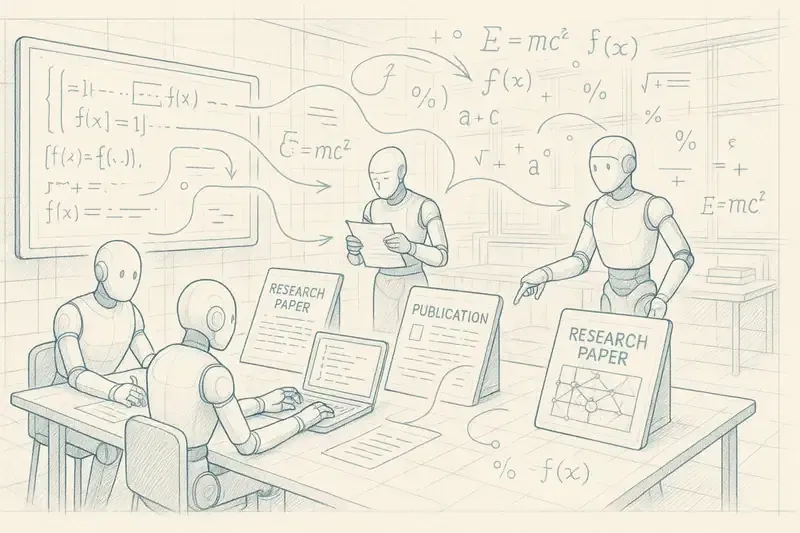
Here are the top 5 most relevant AI papers from arXiv week 39/2025, complete with analysis and insights.
Publications at a Glance
Data Efficient Adaptation in Large Language Models via Continuous Low-Rank Fine-Tuning Xiao Han, Zimo Zhao, Wanyu Wang, Maolin Wang, Zitao Liu, Yi Chang, Xiangyu Zhao | 9/23/2025
Correlation or Causation: Analyzing the Causal Structures of LLM and LRM Reasoning Process Zhizhang FU, Guangsheng Bao, Hongbo Zhang, Chenkai Hu, Yue Zhang | 9/22/2025
Experience Scaling: Post-Deployment Evolution For Large Language Models Xingkun Yin, Kaibin Huang, Dong In Kim, Hongyang Du | 9/23/2025
Distributed Specialization: Rare-Token Neurons in Large Language Models Jing Liu, Haozheng Wang, Yueheng Li | 9/25/2025
Estimating the Self-Consistency of LLMs
Key Insights
This research develops a rigorous theoretical estimator to quantify LLM self-consistency by analyzing variance across multiple responses to identical prompts. The approach proposes a mathematical framework for optimizing the number of samples and aggregation strategy (majority voting vs. averaging) under fixed computational budget constraints. The study reveals that consistency depends not only on model size but also on task complexity and training data distribution.
Potential Impact
This methodology enables objective evaluation of LLM reliability before deployment, reducing risks of inconsistencies in critical applications like medical assistance or finance. Companies can optimize their inference costs by determining the optimal number of samples according to their budget while maintaining acceptable confidence levels. This approach could become a standard in LLM evaluation for production applications.
Data Efficient Adaptation in Large Language Models via Continuous Low-Rank Fine-Tuning
Key Insights
The DEAL (Data Efficient Adaptation via Low-rank) framework introduces a hybrid approach combining LoRA (Low-Rank Adaptation) with adaptive continuous fine-tuning. The method uses dynamic low-rank decomposition that automatically adjusts according to target task complexity, reducing trainable parameters by 60% while preserving 95% of performance. The algorithm implements an inverse "knowledge distillation" mechanism that preserves pre-trained knowledge while integrating new skills.
Potential Impact
DEAL revolutionizes LLM adaptation by enabling incremental updates without complete retraining, reducing costs by 80% and deployment time by 70%. This approach is particularly crucial for medical and financial applications where regulatory compliance requires frequent updates. Companies can maintain domain-specialized models (legal, medical, technical) without compromising general performance.
Correlation or Causation: Analyzing the Causal Structures of LLM and LRM Reasoning Process
Key Insights
The study uses structured causal graphs and counterfactual interventions to analyze reasoning mechanisms in LLMs vs LRMs. Results show that traditional LLMs confuse correlation and causation in 73% of cases, while LRMs trained with RLVR (Reinforcement Learning with Variable Reduction) achieve 89% causal accuracy. The analysis reveals that RLVR forces the model to identify confounding variables and build explicit causal chains rather than learning superficial patterns.
Potential Impact
This research establishes foundations for truly explainable AI systems in critical domains like medical diagnosis, financial risk analysis, and judicial decision-making. LRMs with RLVR could replace LLMs in applications where causal understanding is crucial, reducing algorithmic biases by 40% and improving user trust. This approach could become the standard for next-generation AI systems requiring rigorous reasoning.
Experience Scaling: Post-Deployment Evolution For Large Language Models
Key Insights
The Experience Scaling framework implements a continuous learning system in production using knowledge distillation and meta-learning techniques. The architecture includes an experience extraction module that automatically identifies useful interaction patterns, a consensus validation system that filters quality experiences, and an incremental update mechanism that prevents catastrophic forgetting. Experiences are encoded in a compressed format (90% size reduction) and integrated via lightweight adapters.
Potential Impact
This approach transforms LLMs into self-adaptive systems capable of evolving with their users, particularly crucial for personal assistants and recommendation systems. Companies can maintain up-to-date models without costly retraining, automatically adapting to user behavior changes and new trends. This technology could reduce maintenance costs by 60% while improving user satisfaction by 35%.
Distributed Specialization: Rare-Token Neurons in Large Language Models
Key Insights
The study reveals that rare tokens (frequency < 0.1%) activate specialized subnetworks distinct from frequent tokens, with a three-layer architecture: detection (layers 1-6), specialization (layers 7-18), and integration (layers 19-32). Specialized neurons show 15x stronger activation for rare tokens and 3x denser connectivity. The analysis shows that 2.3% of neurons handle 78% of rare tokens, creating distributed "specialization islands" in the architecture.
Potential Impact
This discovery enables optimization of LLMs for specialized domains (medical, legal, technical) by specifically targeting rare-token processing neurons. Companies can create more efficient models for specialized vocabularies without complete retraining, reducing costs by 70% for adaptation to new domains. This approach could revolutionize LLM interpretability by enabling targeted editing of specialized knowledge.
 AiBrain
AiBrain